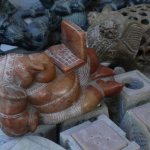Ok.. I am talking pepper here guys.. so calm down! 😉
Well.. you know Indian is the Original Spice Land.. so when it comes to spices.. we oughta be first too .. aint it? So, how dare the Mexicans or whoever with that habanero try to claim itself as the hottest chilli? We bounced back with something that is around a 100 times hotter than the Jalapeno in your supermarket! And the name of this pepper translates into – Ghost Pepper…. for good reason! It is found in Assam… and it is TWICE as hot as the nearest contender – whom it replaces in the Guinness Book of records.
Bhut Jolokia comes in at 1,001,304 Scoville heat units, a measure of hotness for a chilli. It is nearly twice as hot as Red Savina, the variety it replaces as the hottest. By comparison, an average jalapeno measures at about 10,000.
Paul Bosland, a regents professor at New Mexico State University, recalls taking a bite of the chilli pepper and feeling like he was breathing fire. He gulped down a soda, thinking, "That chilli has got to be some kind of record."
The pepper was found by this professor Bosland.. who then had it tested out by taking some seeds and checking the plant out in comparisons with the other varieties.. and for sure it made mince meat of the other hotties!
A member of the university’s Chile Pepper Institute who was visiting India sent Bhut Jolokia seeds back to New Mexico for testing in 2001. The plant does not produce fruit easily, so it took some years to get enough for field testing, Bosland said.
He then grew Bhut Jolokia, Red Savina and habanero peppers under controlled settings and found that Bhut Jolokia had significantly higher Scoville ratings. Those findings were confirmed by two independent laboratories.
The Bhut Jolokia variety has potential as a food additive in the packaged food industry, Bosland said. It could be pickled while green, dehydrated and used as seasoning. Because the heat is so concentrated, food manufacturers would save money because they would use less.
Powered by Qumana















